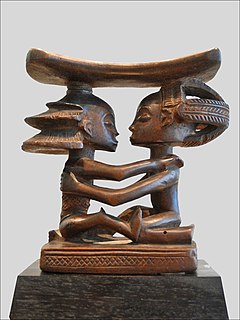Mise-en-scène is an expression used to describe the design aspect of a theatre or film production, which essentially means "visual theme" or "telling a story"—both in visually artful ways through storyboarding, cinematography and stage design, and in poetically artful ways through direction. It is also commonly used to refer to single scenes within the film to represent the film. Mise-en-scène has been called film criticism's "grand undefined term".

Absurdist fiction is a genre of fictional narrative, most often in the form of a novel, play, poem, or film, that focuses on the experiences of characters in situations where they cannot find any inherent purpose in life, most often represented by ultimately meaningless actions and events that call into question the certainty of existential concepts such as truth or value. Common elements in absurdist fiction include satire, dark humor, incongruity, the abasement of reason, and controversy regarding the philosophical condition of being "nothing." Works of absurdist fiction often explore agnostic or nihilistic topics.

Un Chien Andalou is a 1929 Franco-Spanish silent surrealist short film by Spanish director Luis Buñuel and artist Salvador Dalí. It was Buñuel's first film and was initially released in 1929 with a limited showing at Studio des Ursulines in Paris, but became popular and ran for eight months.

Luis Buñuel Portolés was a Spanish filmmaker who worked in France, Mexico and Spain.
The Eight Banners were administrative/military divisions under the Qing dynasty into which all Manchu households were placed. In war, the Eight Banners functioned as armies, but the banner system was also the basic organizational framework of all of Manchu society. Created in the early 17th century by Nurhaci, the banner armies played an instrumental role in his unification of the fragmented Jurchen people and in the Qing dynasty's conquest of the Ming dynasty.

The following is a bibliography of the Sierra Nevada of California, United States, including books on recreation, natural history, and human history.
Raymond Durgnat was a British film critic, who was born in London of Swiss parents. During his life he wrote for virtually every major English language film publication. In 1965 he published the first major critical essay on Michael Powell, who had hitherto been "fashionably dismissed by critics as a 'technician’s director'", as Durgnat put it.

The Luba people or baLuba are an ethno-linguistic group indigenous to the south-central region of the Democratic Republic of the Congo. Majority of them live in this country, residing mainly in its Katanga, Kasai, and Maniema provinces. The baLuba consist of many sub-groups who speak various dialects of Luba or other languages, such as Swahili.

The Kāpālika tradition was a non-Puranic form of Shaivism in India. The word Kāpālikas is derived from kapāla meaning "skull", and Kāpālikas means the "skull-men". The Kāpālikas traditionally carried a skull-topped trident (khatvanga) and an empty skull as a begging bowl. Other attributes associated with Kāpālikas were that they smeared their body with ashes from the cremation ground, revered the fierce Bhairava form of Shiva, engaged in rituals with blood, meat, alcohol, and sexual fluids.
Surrealist cinema is a modernist approach to film theory, criticism, and production with origins in Paris in the 1920s. The movement used shocking, irrational, or absurd imagery and Freudian dream symbolism to challenge the traditional function of art to represent reality. Related to Dada cinema, Surrealist cinema is characterized by juxtapositions, the rejection of dramatic psychology, and a frequent use of shocking imagery. Philippe Soupault and André Breton’s 1920 book collaboration Les Champs Magnétiques is often considered to be the first Surrealist work, but it was only once Breton had completed his Surrealist Manifesto in 1924 that ‘Surrealism drafted itself an official birth certificate.’

King Salmon is an unincorporated community in Humboldt County, California, United States, located on the shore of Buhne Point directly across from the entrance to Humboldt Bay, slightly south of Eureka and 1 mile (1.6 km) north of Fields Landing, at an elevation of 3 feet (0.91 m). has a Eureka zipcode and area code and is part of Greater Eureka although outside the city limits.
William A. Christian Jr. is an American religious historian, and was the J.E. and Lillian Byrne Tipton Distinguished Visiting Professor in Religious Studies at University of California, Santa Barbara. Christian is a graduate of the University of Michigan.
The Imperial Clan Court or Court of the Imperial Clan was an institution responsible for all matters pertaining to the imperial family under the Ming and Qing dynasties of imperial China.

Cela s'appelle l'aurore is a 1956 Franco-Italian film, directed by Luis Buñuel. It was written by Buñuel and Jean Ferry, based on a novel by Emmanuel Roblès.

Ángel Sampedro Montero, better known as Angelillo, was a Spanish singer of popular songs in his time. He has been described as a "popular idol of the flamenco copla", a very particular style of flamenco, along with fandangos, soleares, saetas, caracoles and tarantas etc. He was also one of the earliest singers to sing in a forced falsetto in flamenco. He was also an actor in musical films of Andalusian folklore: He appeared in films such as La hija de Juan Simón (1935) and Suspiros de Triana (1955), becoming a film star for Filmófono and working with esteemed directors such as Luis Buñuel, which led to him being nicknamed “the nightingale of Andalusia”.

La hija de Juan Simón is a musical play by Nemesio M. Sobrevila, which has been made into two Spanish films. It is also the name of the title track, and the song has been recorded by numerous artists such as Leonardo Favio.

Mauprat is a 1926 French silent drama film directed by based on the eponymous novel by George Sand. Luis Buñuel who had enrolled in Jean Epstein's acting school was the production assistant and had a small acting role.

Luis Buñuel Portolés was a Spanish filmmaker who worked in Spain, Mexico and France. His style of filmmaking and the influences upon his filmmaking technique have been studied extensively in film criticism and film theory.











